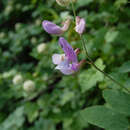Physical Description
provided by USDA PLANTS text
Perennial, Herbs, Plants with rhizomes or suckers, Taproot present, Nodules present, Stems erect or ascending, Stems or branches arching, spreading or decumbent, Stems prostrate, trailing, or mat forming, Stems less than 1 m tall, Climbing by tendrils, Stems solid, Stems or young twigs glabrous or sparsely glabrate, Leaves alternate, Leaves petiolate, Stipules conspicuous, Stipules green, triangulate to lanceolate or foliaceous, Stipules persistent, Stipules free, Stipules cordate, lobed, or sagittate, Leaves compound, Leaves even pinnate, Leaf or leaflet margins entire, Leaflets opposite, Leaflets alternate or subopposite, Leaflets 5-9, Leaflets 10-many, Leaves glabrous or nearly so, Flowers in axillary clusters or few-floweredracemes, 2-6 flowers, Inflorescences racemes, Inflorescence axillary, Bracts very small, absent or caducous, Flowers zygomorphic, Calyx 5-lobed, Calyx glabrous, Petals separate, Corolla papili onaceous, Petals clawed, Petals blue, lavander to purple, or violet, Banner petal ovoid or obovate, Banner petal suborbicular, broadly rounded, Wing petals narrow, oblanceolate to oblong, Wing petals auriculate, Wing tips obtuse or rounded, Keel tips obtuse or rounded, not beaked, Stamens 9-10, Stamens diadelphous, 9 united, 1 free, Filaments glabrous, Style flattened, Style hairy, Style hairy on one side only, Style persistent in fruit, Fruit a legume, Fruit unilocular, Fruit freely dehiscent, Fruit elongate, straight, Fruit exserted from calyx, Valves twisting or coiling after dehiscence, Fruit glabrous or glabrate, Fruit 3-10 seeded, Seeds ovoid to rounded in outline, Seed surface smooth, Seeds olive, brown, or black.
Lathyrus pauciflorus: Brief Summary
provided by wikipedia EN
Lathyrus pauciflorus, known by the common name of few flowered peavine, is a perennial plant species in the Fabaceae family.
- license
- cc-by-sa-3.0
- copyright
- Wikipedia authors and editors

